What time is it? Time for the riders to leave the Alps and move to the foothills of the Jura. Back in the 19th century, there was already geological research in this region. The famous German geologist Alexander Von Humboldt found that a package of limestones can be traced throughout the Jura. He therefore called them Jurassic limestones. These also reappeared on the western side of the Alps, at the beginning of the stage. In these rocks we find creatures that tell us what time it is.
Geologists noticed that these limestones contained large fossils: beautiful, wound snails with chambers in them. These fossils had already been known found for a long time. Egyptians and later Greeks called them ‘the Horns of Ammon’, after an Egyptian god with horns like a mountain goat. Later we named those fossils after this god: ammon-ite!

When geologists found that the ammonites of southern England and the Jura were the same species, and appeared and disappeared in the same order in the rock sequence, they defined this as a period in the geological timescale. They named it after the Jura limestones: the Jurassic. The clearest ‘guide fossils‘ were the ammonites.
Marvellous design
In geology and archaeology, a recurring topic is always: how old is something? What time is it? There are various ways to date rocks. In sedimentary rocks, the quickest way can be to use guide fossils. When dating marine deposits, scientists often use fossil shells of ammonites. The ammonites are an extinct group of shellfish. You could say calamaris in a shell because they are actually a type of squid. Of that group, called cephalopods, there are now two groups left: Nautiluses and the group of Coleoids consisting of, among others, the octopuses, the ten-armed animals, including cuttlefish and an obscure “group” called Spirulida (with just one species).
Many members of this group have/had the special skill of building chambered shells. These empty chambers were connected to each other via a tube. The pressure in each chamber could be regulated via that tube. This tube is clearly visible in the nautilus below.
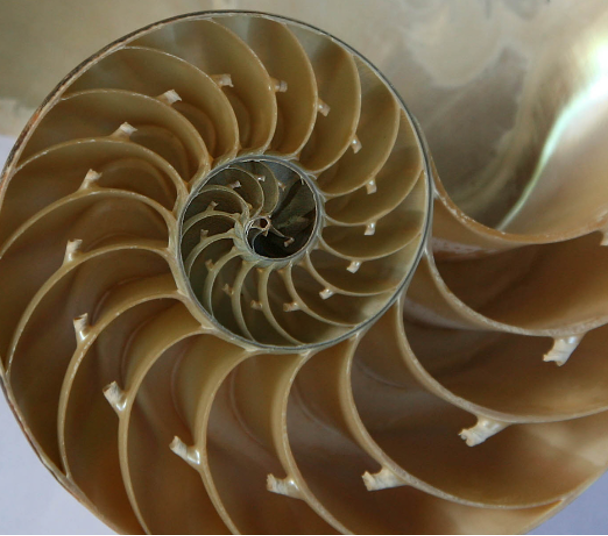
Nautilus
Although the Dutch, and especially Cornelis Drebbel, may proudly say that the invention of the submarine came from the Netherlands, the Nautiloidea preceded the boat by about half a billion years. These submarines have been floating around in our seas since the Cambrian period. Cambrian is named after Wales, by the way. Who knows whether the real inventor Jules Verne had the knowledge to have purposely put the name Nautilus on Captain Nemo’s ship?
Back to half a billion years ago. The chambered shell gave the Cambrian cephalopods a unique advantage. While other species organized their pedestrian lives on or in the seabed, the cephalopods could float above it and move faster. Fast, however would probably be an exaggeration. The ancestors of what would one day become the vertebrates were still quite harmless. From the moment they entered history, they have been a successful group. They became an important part of the marine environment.
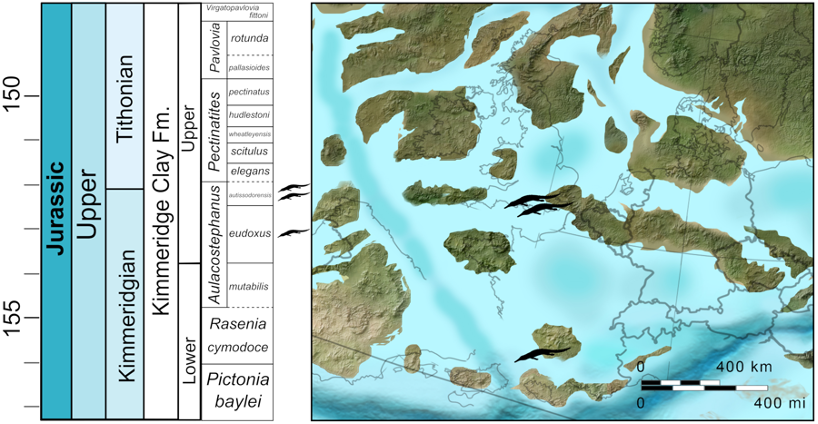
Remains of cephalopod shells can be found in almost all marine sediments in the world. As the image below shows, France was mostly shallow seas so we find them in abundance. About 66 million years ago, at the end of the Cretaceous, the group of ammonites ended. They went extinct together with the dinosaurs.
Fossils as clocks
The presence across time periods explains part of the relevance of why we can use ammonites for dating. An important other element is change. If a celebrity like Will Smith had given the same autograph to fans throughout his life, you would never be able to tell when Will Smith had signed it. Because he changed his signature slightly every so often, we can say something about that. It’s no different with ammonites although they are not men in black. Their shell changed regularly.
Around 1850, two Germans noticed that there were a lot of these shells in Jurassic rocks of the Swabian and Frankish Alps in southern Germany, across the border from France, and that new shapes were constantly emerging over time. Moreover, they figured out that if you find the same shell in a different place, you are probably digging in the same geological period. This is the principle of a guide fossil.
Quenstedt and Oppel made themselves immortal with this concept. The ammonite families Quenstedtoceras and Oppelia, among others, bear their name. Due to their frequent variation in shape, it is possible to say something about their age accurately within 200,000 thousand years, according to the British Geological Survey. On the geological time scale of four billion years that is very accurate!
Pretty trinkets
It is unknown who first collected fossils such as ammonites but humans have been interested in fossils from very early on. In many myths or legends you can find hints and sometimes there is even concrete evidence for it. One example is in Thurgau in Switzerland. In addition to bronze jewelry, an ammonite and a shark tooth were found in a 3,500-year-old grave. There are even indications that the beauty of fossils was already appreciated 500,000 years ago
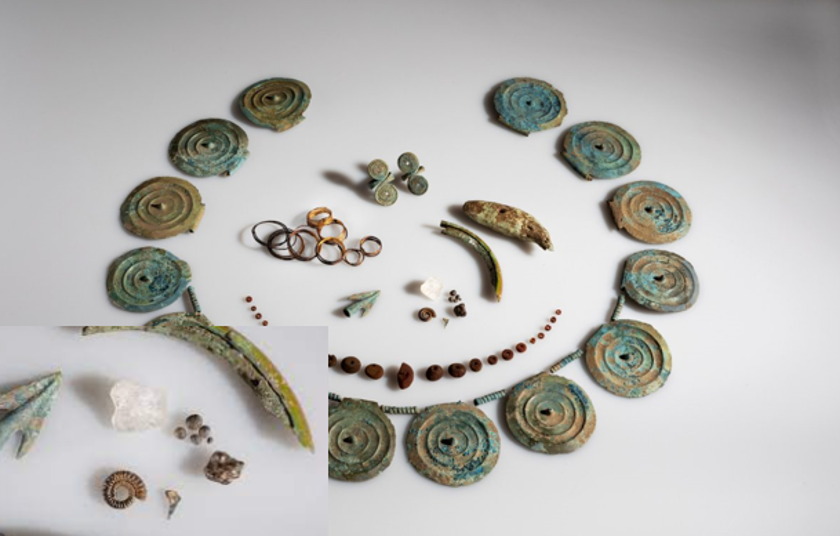
Why change?
What drove the variation in shell shape and construction? It seems logical to assume that the environment/biotope has influenced ammonites. During the rise of the ammonites there were many habitats to be filled in deep and shallower seas. What started as a straight shell literally went in all directions.
The variation in ammonites is not only in size and shape, but also in the complexity of the suture lines. This is the pattern of lines that can be observed on the outside of the fossil shell. They are the edges of the dividing walls between the chambers. These suture lines play an important role in assessing the mutual relationships and species determination. With ammonites they go from simple to increasingly complex (although there are exceptions to this).
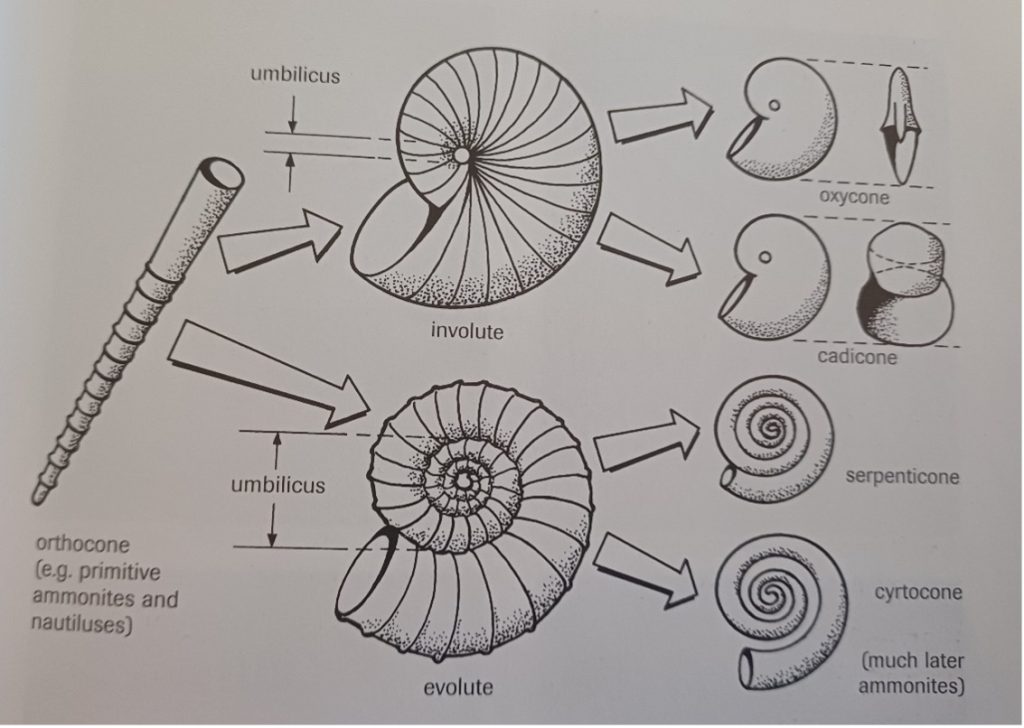
More complex suture lines give extra strength to the shell. You often hear that this complexity is related to the increasing pressure of the water at greater sea depths. That doesn’t seem entirely logical. That is, if you look at the original sea depths where ammonite fossils are found, it is noticeable that they mainly occur in shallow coastal areas (depth 50 to 200 meters). Modern nautiluses with their simple shells live no deeper than 200 to 400 meters. Depth therefore does not seem convincing for the complex chamber devisions.
It is currently believed that the complicated suture lines are mainly related to the emergence of predators. The more complicated the chambers are, the less likely it is that the bite of an ichthyosaur will actually be life-threatening.
Go faster!
Perhaps there is another argument. How fast do you think an ammonite could swim? Like modern octopuses, ammonites appear to have had waterjet propulsion. That seems very cool, but because of how the animal fitted in the shell and where the center of mass was, it’s probably more tortoise than a hare. They wouldn’t make it within the time limit. That’s for sure.
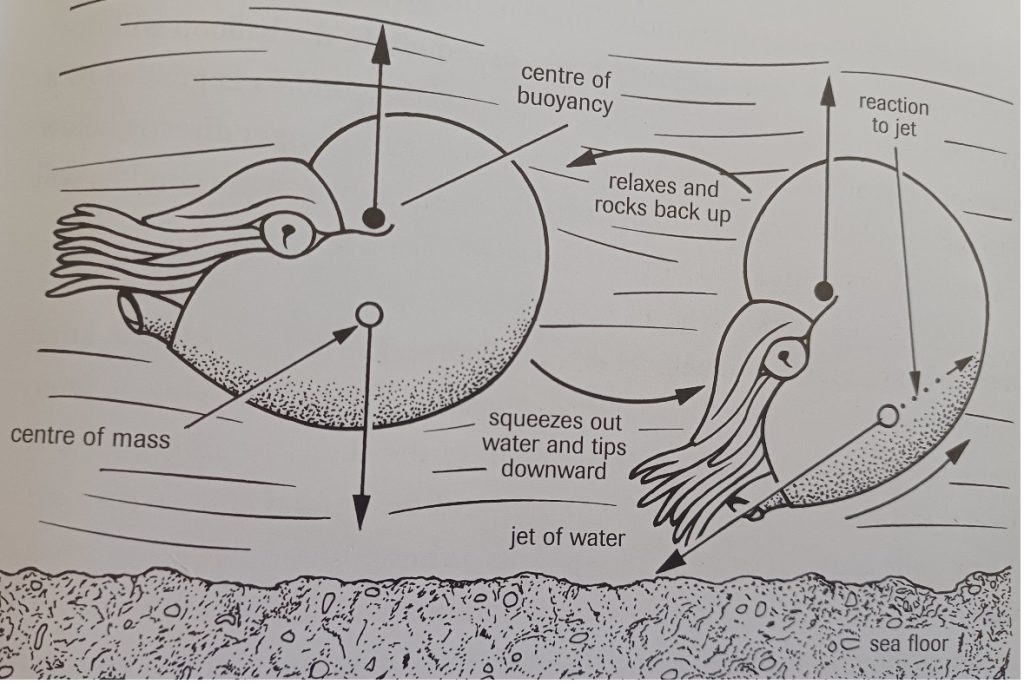
If you don’t have much speed to flee from predators, you better think of something else. Survival is key. We see many different survival mechanisms, for example, a very sturdy shell or a very convex one. There are also shells with annoying spines. We all encounter these variations with ammonites.
Around the world
The great thing about ammonites is that they occur worldwide. However, determining age and therefore telling what time it is, is not always possible because not all types of ammonites can be found everywhere. Some species did occur in various locations in the world, locations that are quite far apart. That seems crazy if you’re a slow species that evolved fast. Plate tectonics obviously plays a role in this.

In the Jurassic, for example, America and Europe were next to each other. It is most likely for this reason that I found the ammonite genus Cardioceras in both Wyoming (USA) and Northern France. In Wyoming this gave a special feeling of recognition in a completely new place. At that moment there was immediate confirmation that the layers there were about 150 million years old. What time is it? The ammonite tells you.
Talking about “cardio”-ceras. Today, the riders could also encounter this species if they would dig for them in the limestones along the road! They would probably give anything to be able to climb like ammonites just by releasing the pressure in a shell on their back. Unfortunately for them, it will take muscle strength in their legs, and lots of rice cakes, if they want to get to the top!
NB: Blogs in other languages than English are all auto-translated. Our writers are not responsible for any language and spelling mistakes.








